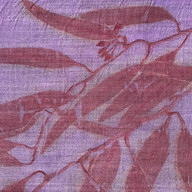Prune de Monsieur, the French Mordant for Logwood
- Suzanne Dekel
- Jan 15, 2020
- 6 min read
Updated: Dec 1, 2021
Prune de Monsieur, the durable logwood mordant.
The logwood discoveries have been ongoing over the last few months.

Logwood (campecheianum heamatoxylon) really is a crowd pleaser. Stunning purples, blues, greys and blacks from a tree that is fast-growing, easy to use in dyeing, and extra bonus; economical. it would have been the greatest dye on earth if it were not rather fugitive…So much so, that Queen Elizabeth banned the use of it in her 23rd year of reign, under severe penalties. In a previous blog I discussed the recipes for logwood purples and blues and here you can find the recipe for true logwood black.
So why was the logwood so popular for use if it was not thought to be light-fast? The reason is simple; it was a rather cheap dye, easily available as it could be imported from different countries such as Belize without a specific country holding a monopoly. For a good purple the only other way would be dyeing with indigo, overdyed with Cochineal. Indigo at that time was at an all time high price, the market was dominated by the much hated English who imported Indigo from India and Jamaica. The highest quality of cochineal import from Mexico on the other hand was still in hands of the Spanish, who kept the price high. (An interesting article about Cochineal production and prices can be found here)
Edward Bancroft writes in his book "Philosophy of permanent colours, Volume 2";

“The best and least fugitive of the purple or violet colours obtained from logwood, are produced by mordants composed of solutions of tin; one of these became very fashionable in France, about thirty years ago, under the name of prune de Monsieur; and being then a resident at Paris, I wore a coat of this colour, without having any reason to complain of it as being fugitive.”
Checking the net for 18th century purple coats I found the following samples;
Pretty hues for sure. And if they are light fast (er) even better.
So what was this illustrious mordant? This is how the story goes;
Around 1775 Mr Giros de Gentilly worked at a French sheet manufacturer in Louviers. Louviers was a well known town of wool cloth manufacturers in Normandie. This dye specialist was born in England under the name George Palmer (ca. 1746 – March 3, 1826).
He made the significant discovery of using tin and copper as a mordant for wool, creating a lasting purple using logwood and improving the hand of the wool for spinning.
It appears he loved to chatter a lot about his discoveries as a chemist named Mr Decroizille (1781-1825) tells the famous dye specialist Berthollet;

“His first essays were made at Louviers with Messrs Petou (the nephew) and Frigard about twelve years ago. From what he had suffered to transpire respecting the substances which composed his mordant I succeeded in imitating him tolerably well. I made a solution of tin in sulphuric acid to which I then added muriat of soda, red acidulous tartrit of potash, and sulphat of copper.
My success was so great as to inauce Mr Giros to offer me a partnership in the very lucrative trade in this article which he carried on at Louviers, Elboeuf, Abbeville, Sedan and the Pays de Liege.
Mr Giros then taught me a much more convenient mode of forming this compound, it consists in making a solution of tin in a mixture of sulphuric acid, muriat of soda and water, to this solution the tartrit and sulphat are added in the form of powder. Of this mordant we made no less than fifteen hundred quarts in twenty four hours in a single leaden vessel moderately heated.”
The business was very profitable until Mr Giros once more chattered a bit too much:
“We carried on a very profitable trade in this article at the rate of thirty sols fifteen pence English per pound for three years, since which time it constantly declined until we lost it altogether, the reason of which was this Mr Giros having suffered his secret to transpire.
We had a number of imitators who at first succeeded in a less degree but afterward better than ourselves In a compound consisting of so many ingredients as this in an operation, which is still so obscure as that whereby colours are fixed it is almost impossible to arrive at perfection by any other means than random trials, which may be infinitely varied by the different proportions and more especially by the modus agendi, and to a much greater extent than chemists who had bestowed less time on this subject than I have done would suppose. I am therefore not ashamed to confess that I was forced to abandon the business while I saw and still see those who are no chemists deriving a very comfortable profit from it “
Decroizille continues to explain how the mordant is made;
“Having given you the history of the mordant for the prune de Monsieur I shall mention the mode of employing it, and its effects.
If it be wool in the fleece which is to be dyed one third of its weight of mordant is required if it be a stuff only one fifth is necessary
A bath is prepared of a degree of heat which the hand can bear with which the mordant is well mixed and the wool or stuff dipped into it and properly stirred the same degree of heat being kept up for two hours and even increased a little at last. It is then taken out aired and very well washed a fresh bath of pure water at the same heat is prepared a sufficient quantity of the decoction of logwood is added the stuff immersed stirred and the fire increased to a boiling heat which is continued for a quarter of an hour the stuff being then taken out aired and carefully rinsed the dyeing is finished If the decoction of one pound of logwood have been employed for three pounds of wool, and a proportionate quantity for stuffs which require less a fine violet is produced to which a sufficient quantity of brazil wood gives the shade commonly known by the name of prune de Monsieur.
So now we know that the mordant is made out of the following ingredients;
tin = stannous chloride (SnCl2)
sulphuric acid = Vitriol (H2SO4 )
muriate of soda = Sea salt
Tartit of Potash = Cream of Tartar (KC₄H₅O₆)
Sulphate of copper = ( CuSO4(H2O)x )
We also know that we need 33%WOF of the mordant for wool fleece, and 20%WOF for woven goods.
We also know the mordant has to be hot, but not above 60ºC which would be too hot for the hand to bear. (In Hebrew we have the term 'Yad Soledet' which is the moment you withdraw your hand because the liquid is too hot, and it was decided this is 60ºC.)
The material needs to be stirred regularly.
The materials need to be in the mordant for two hours.
The materials are taken out of the mordant and aired.
The dye is made from 30%WOF of logwood shavings.
To get the right shade, brazil wood is added in a ‘sufficient quality’.
Edward Bancroft writes ;
"(Silk) to give it the colour which in France is called prune de Monsieur. To produce this colour however Fabroni has recommended a mordant prepared by combining the muriate of tin with sulphate of copper and tartar and employing a small proportion of galls or of alder bark with the logwood in the dyeing liquor. Berthollet has observed that silks which had been impregnated with solutions of tin at different degrees of oxidation being afterwards dyed with logwood he found that the best effects were produced on those to which tin the least oxygenated had been applied."
I was unable to find the original writings of mr Fabrioni, but we understand that silk would benefit from an addition of oak gall tannin.
We still do not know now, what the proportions of the mordant are, and surely, in the home based studio we can’t dye with sulphuric acid. So this is where the experiments started.
If I take into consideration that I need 20%WOF of mordant altogether, my numbers come to;
5% tin
5% cream of tartar
5% Copper sulphate
5% sea salt
.
I made the mordant by diluting the powder in hot water in a stainless steel bucket, topping up until it would cover my fabrics and then slowly heating while working regularly and keeping the textile underneath the surface at all times.
Now to the experimenting. I prepared the following;
Samples of wool and silk with and without the sea salt.
Samples with and without the addition of lime.
Samples of silk with addition of 5% oak galls.
After mordanting I took the materials out of the water and wrung, aired for a few minutes while I prepared the dye bath with 20% WOF of logwood sawdust.
Samples without Brazilwood, with 10% Brazilwood and with 5% Brazilwood.
When I look at pictures of original 18th century purple coats, the samples with 10% Brazilwood with and without lime seem to come the closest to an original plum shade.


On Wool the colours are just as pretty as on silk.


A second exhaust bath delivered slightly lighter colours.
A third bath was no longer sufficient in dye stuff to get a good result.

Update 1-12-2021:
Some eco printing with red-printing eucalyptus on wool dyed with the Prune des Monsieur recipe. I used my favourite Organic Wool for this.
















